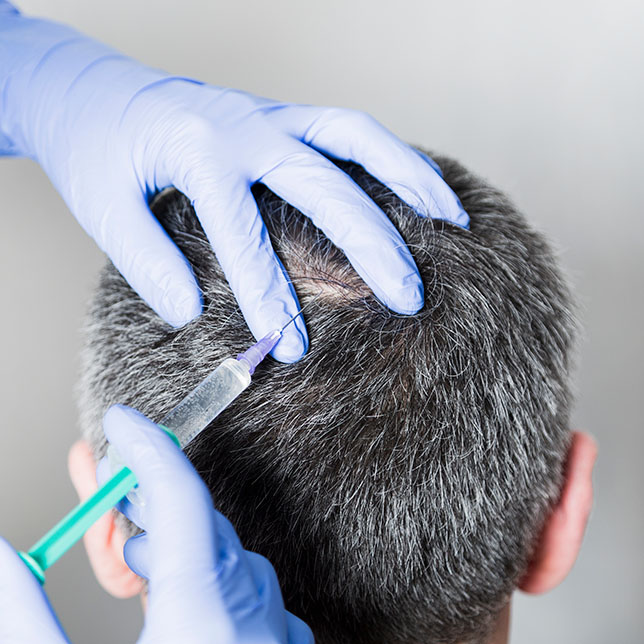Alopecia/hair loss
Home • Dermatology • Common Skin Conditions • Alopecia/hair lossTypes of Alopecia
Alopecia, commonly referred to as hair loss, encompasses various forms, each with distinct causes and treatment approaches.
Here’s a breakdown of some common types of alopecia:
- Alopecia Areata – Alopecia areata is an autoimmune condition characterized by sudden, patchy hair loss. It can affect the scalp, face (such as eyebrows and beard), and other body parts. Treatments may include corticosteroids, minoxidil, and other medications that modulate the immune system.
- Androgenetic Alopecia – Often known as male or female pattern baldness, this type is related to genetic factors and hormonal changes. It’s marked by a receding hairline and thinning hair on the crown in men and thinning hair along the central scalp in women. Treatment options include minoxidil, finasteride/dutasteride,, and hormonal therapies for women.
- Central Centrifugal Cicatricial Alopecia (CCCA) – CCCA primarily affects women of African descent and starts at the crown of the scalp, spreading outward. It can lead to scarring and permanent hair loss if not treated early. Treatments focus on anti-inflammatory medications, such as corticosteroids and antibiotics.
- Frontal Fibrosing Alopecia (FFA) – This form typically presents as a symmetrical band of hair loss at the front of the scalp. It is slowly progressive and often associated with loss of eyebrows. The treatment may involve medications to prevent further hair loss and manage symptoms.
- Traction Alopecia – Caused by constant pulling on the hair due to tight hairstyles, this type can lead to gradual hair loss, primarily around the temples and forehead. Early stages might be treated by changing hair practices, while advanced cases might require medications or surgery.
- Telogen Effluvium – This temporary form of hair loss is usually triggered by stress, illness, hormonal changes, or medications. Hair typically grows back once the underlying cause is addressed.
Treatment
Each type of alopecia has its own set of treatment options tailored to the underlying causes and specific characteristics of the hair loss. Here is a detailed look at the treatment approaches for different types of alopecia:
- Alopecia Areata
-
- Corticosteroids: These can be administered via local injections into the scalp, topical application, or orally to suppress the immune response that attacks hair follicles.
- Topical Immunotherapy: Chemicals like diphencyprone (DPCP) are applied to the scalp to induce an allergic rash, which can alter the immune response and stimulate hair growth.
- Minoxidil (Rogaine): Often used in conjunction with other treatments, it can promote hair regrowth in alopecia areata patients.
- Biologics. Olumiant
- Androgenetic Alopecia (Male and Female Pattern Baldness)
-
- Minoxidil (Rogaine): Available over-the-counter, it’s used to stimulate hair growth in both men and women.
- Finasteride and Dutasteride: These prescription oral medications are available for men and post-menopausal women and work by blocking the formation of the hormone (DHT) that leads to hair loss.
- Central Centrifugal Cicatricial Alopecia (CCCA)
-
- Antibiotics: To reduce inflammation.
- Corticosteroids: To help reduce scalp inflammation.
- Hair transplantation: In cases where scarring has stabilized and active inflammation has been controlled.
- Frontal Fibrosing Alopecia (FFA)
-
- Corticosteroids: To reduce inflammation around the hair follicles.
- Oral anti-inflammatory medications: Such as hydroxychloroquine or doxycycline, to manage the immune response affecting the scalp.
- 5-alpha-reductase inhibitors: Like finasteride or dutasteride, which may help slow down the hair loss process.
- Traction Alopecia
-
- Changing hairstyling practices: Avoiding tight hairstyles is the primary treatment to prevent further hair loss.
- Topical or injectable steroids: To reduce inflammation if there is evidence of ongoing scalp tension.
- Minoxidil (Rogaine): To potentially help regrow hair in affected areas.
- Telogen Effluvium
-
- Addressing underlying causes: Such as stress management, correcting nutritional deficiencies, or stopping a medication under supervision.
- Topical Minoxidil (Rogaine): To help accelerate hair regrowth.
Each treatment must be tailored to the individual’s specific type of alopecia and their overall health. It is essential for patients to consult with a dermatologist to obtain a proper diagnosis and a comprehensive treatment plan.
Treatment